Introduction: Gena Philibert-Ortega is a genealogist and author of the book “From the Family Kitchen.” In this blog post, Gena reads old newspaper articles to learn about a strange episode from the past: a fatal train crash that was deliberately staged in Texas in 1896 as a publicity stunt.
Our ancestors experienced some strange events that never made it into the history text books and have been largely forgotten now. In September 1896 many people witnessed—and even more read about in the newspapers and discussed with their family and friends—a fatal train crash in Texas that was caused deliberately as a bizarre public event.
There’s something about wrecks that fascinates us—it seems to be human nature to stare at them even though we know we shouldn’t. Our ancestors also had a difficult time averting their eyes from horrific disasters. Media outlets today know that purposely crashing vehicles and exploding things makes for good entertainment, and our 19th century ancestors would have agreed.
The Crash at Crush, Texas
The “Crash at Crush” event was a train wreck, literally, and it was all in the name of publicity. William G. Crush, an employee of the Missouri-Kansas-Texas Railroad (known as the “Katy”), had the idea that he could use two aged train engines, crash them into each other, and people would come to witness the spectacle. And to make sure the crowds would be there, he started his publicity machine early—with newspaper articles and advertising, including announcing the schedule for the two doomed engines on their final trip to Crush. The two engines chosen for the event were brightly painted, one green and one red, and exhibited before the day of the train crash to stir up further interest.
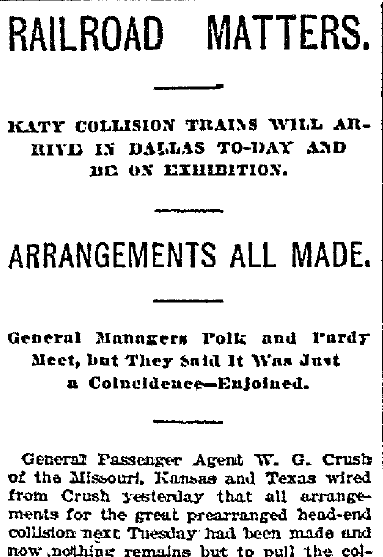
For the crash site, Crush chose a spot in McLennan County, drilled two wells for drinking water for the spectators, and erected circus tents and a grandstand. Admission to the event was free.
On 15 September 1896 the crowds did come; an estimated 30,000-40,000 people were in attendance. The place where Crush staged the crash was known as “Crush, Texas,” a temporary “town” that was specifically created, and dismantled soon after, for the train wreck spectacle. While the event itself was free, attendees did have to pay for a train ticket to get to the crash site. For $2 you could hop a train anywhere in Texas to travel to Crush, 10 miles outside of Waco, to enjoy the festivities. William G. Crush thought of everything to make the event a success—or so he thought.
Crush had considered safety—but he didn’t prepare for every contingency. He constructed a special four-mile stretch of track to hold the two trains, and had the locomotive engineers jump off the trains once the engines were in motion. Spectators were kept a “safe” distance away. Even though Crush was assured that the crash would be safe for spectators, the unexpected happened when the two trains, at 45 miles per hour, crashed headlong into each other.
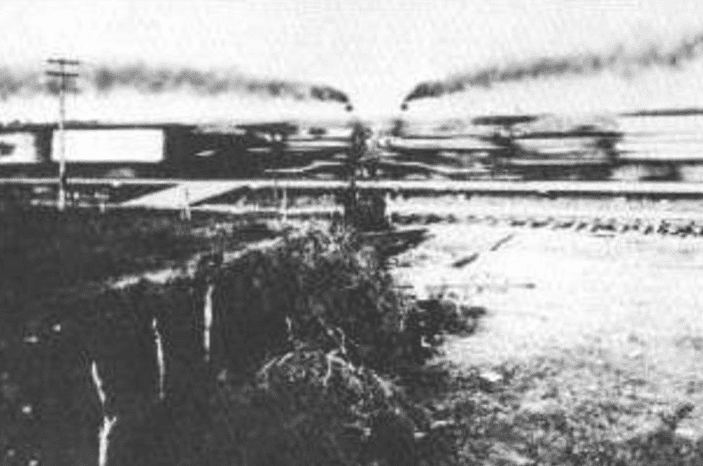
According to this front-page newspaper report:
It was more than a collision. Both engines were completely telescoped and in spite of all precautions both boilers promptly exploded, hurling a shower of iron and steel for several hundred yards around, injuring [nine] persons, two seriously and two perhaps fatally.
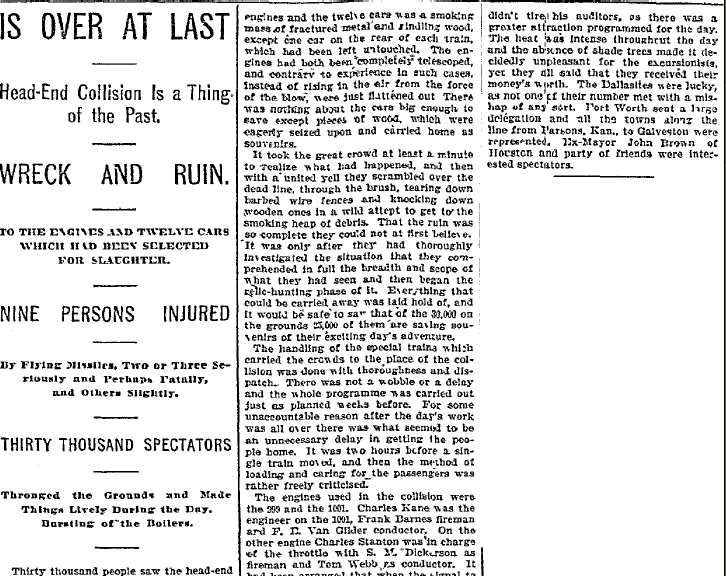
With death and destruction all around them you would assume that those in attendance dispersed right away, fleeing for the safety of home. But no—just like today, not only did people get closer to inspect the damage, they took pieces of the train home as souvenirs and had their photo taken next to the wreckage. Composer Scott Joplin even wrote a song about the event, one he appropriately entitled the “Great Crush Collision March.”*
Eyewitness Accounts in the News
Sixty years after the crash, the Dallas Morning News published eyewitness accounts that recounted everything from the infamous Texas train crash itself to the souvenirs taken from the wreckage. One man, Clitus Jones, stated that a hunk of the train metal was used in his childhood Waco home as a doorstop.
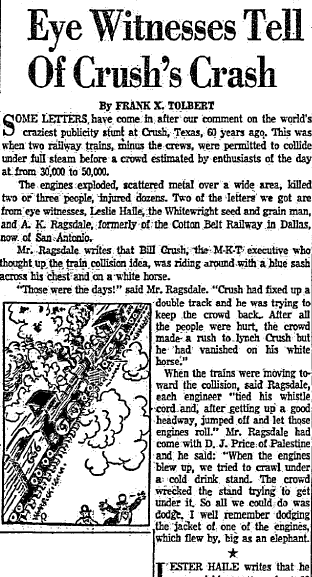
William G. Crush
William G. Crush, the man responsible for the crash, was immediately fired. However, after there wasn’t a huge public uproar over the catastrophe, the Katy hired Crush back the very next day—and he continued working for the railroad and retired after 46 years of service.
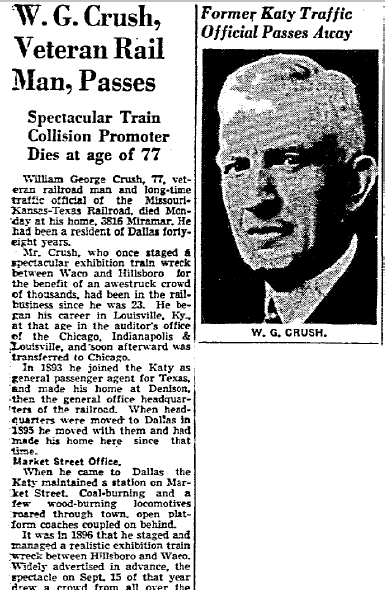
His obituary stated:
The [train crash] exhibition was never repeated, but Mr. Crush was shot into wide renown among railroad men for his keen sense of exploitation.
But Wait, There’s More!
While Crush’s train-crashing days ended as soon as they started, that wasn’t the end of watching train wrecks as entertainment. Other train crashes were staged across the country, including the annual train wreck at the California State Fair from 1913-1917. You can watch a video of the 1913 train crash, complete with the engineer jumping to safety, on Internet Archive: https://archive.org/details/Californ1913. Fast forward to the 5:00 mark to see the crash scenes.
Did our ancestors enjoy a staged train crash? It would appear so, but in retrospect that isn’t any stranger than modern audiences enjoying action-packed movie crashes or a demolition derby. If there’s one thing history teaches us, it’s that the more things change, the more they stay the same.
———————
* For a look at the music from the March and an audio recording, see The Baylor University Libraries Digital Collections Blog article “Scott Joplin’s ‘Great Crush Collision March’ and the Memorialization of a Marketing Spectacle” at: http://blogs.baylor.edu/digitalcollections/2012/04/19/scott-joplin%E2%80%99s-%E2%80%9Cgreat-crush-collision-march-and-the-memorialization-of-a-marketing-spectacle/
Wreck Related Articles:
- Amazing Survival Stories of Last Moments on the ‘Titanic’ Ship
- Amazing True Story of Shipwreck Survival
- Shipwreck of the ‘Essex’ Whaleship: A Real-Life Moby Dick
[bottom_post_ad]
